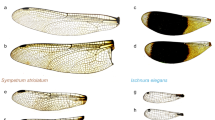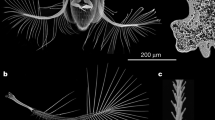Abstract
IN insects belonging to the group Diptera the second pair of wings is modified into a pair of dumbbell shaped organs, called halteres or balancers, which consist of a thickened base bearing numerous sense organs, a shaft, and a swollen blood-filled end (Fig. 1, A). During flight the halteres are vibrated rapidly through an arc of about 90° in the vertical plane with a frequency which is almost certainly identical with that of the wing beat. In Calliphora, Lucilia or Phormia this is about 200 times per second.
This is a preview of subscription content, access via your institution
Access options
Subscribe to this journal
Receive 51 print issues and online access
$199.00 per year
only $3.90 per issue
Buy this article
- Purchase on Springer Link
- Instant access to full article PDF
Prices may be subject to local taxes which are calculated during checkout
Similar content being viewed by others
References
Buddenbrock, W. V., Verh. Heidelb. Nat. Med. Ver., N.F., 13 (1917).
Buddenbrock, W. V., Pflug. Arch., 175, 125 (1919).
Fraenkel, G., Z. vergl. Physiol., 16, 371 (1932).
Pringle, J. W. S., J. Exp. Biol., 15, 114 (1937).
Pflugstaedt, H., Z. wiss. Zool., 100, 1 (1912).
Author information
Authors and Affiliations
Rights and permissions
About this article
Cite this article
FRAENKEL, G., PRINGLE, J. Biological Sciences: Halteres of Flies as Gyroscopic Organs of Equilibrium. Nature 141, 919–920 (1938). https://doi.org/10.1038/141919a0
Issue Date:
DOI: https://doi.org/10.1038/141919a0
This article is cited by
-
Fuelling on the wing: sensory ecology of hawkmoth foraging
Journal of Comparative Physiology A (2019)
-
A faithful internal representation of walking movements in the Drosophila visual system
Nature Neuroscience (2017)
-
Body rate decoupling using haltere mid-stroke measurements for inertial flight stabilization in Diptera
Journal of Comparative Physiology A (2009)
-
The halteres of the blowfly Calliphora
Journal of Comparative Physiology A (1993)
-
Angular acceleration, compensatory head movements and the halteres of flies (Lucilia serricata)
Journal of Comparative Physiology ? A (1980)
Comments
By submitting a comment you agree to abide by our Terms and Community Guidelines. If you find something abusive or that does not comply with our terms or guidelines please flag it as inappropriate.



